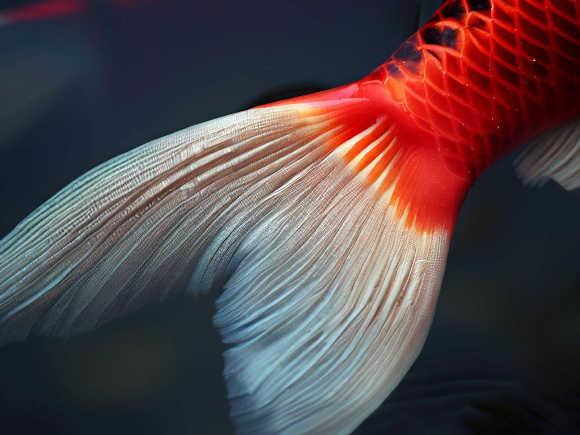Koi fish, originating from Japan, boast an array of fin shapes, sizes, and colors that not only enhance their aesthetic appeal but also biological significance.
Variety in Fin Shapes and Sizes: A Kaleidoscope of Beauty
Koi fish fins come in a remarkable variety of shapes and sizes, contributing to the individuality of each fish. The primary fins of a koi fish include the dorsal fin, pectoral fins, pelvic fins, anal fin, and caudal fin (tail fin). These fins can range from long and flowing to short and compact, each contributing to the fish's overall appearance and swimming capabilities.
- Caudal Fin Diversity: The caudal fin, often referred to as the tail fin, is perhaps the most striking feature of a koi fish. It can be single, double, or even triple lobed, resembling delicate butterfly wings. The shape of the caudal fin can greatly influence the way the koi moves through the water, contributing to its elegance and grace.
- Dorsal Fins and Balance: The dorsal fin, situated along the fish's back, aids in maintaining balance and direction. It can vary in height and length, adding to the visual intrigue of the fish as it glides through the water.
- Pectoral and Pelvic Fins: These fins, located on the sides of the fish, aid in maneuverability and stabilization. Their shapes can differ significantly, affecting the koi's ability to navigate through tight spaces or perform intricate movements.
- Anal Fin Functionality: The anal fin, positioned near the rear of the fish, also plays a role in maintaining stability and direction. Its shape and size contribute to the overall aesthetic harmony of the koi.
Symbolism and Cultural Significance
In Japanese culture, koi fish hold profound symbolic meanings, and their fins are no exception. Koi fish are often associated with perseverance, determination, and overcoming adversity, due in part to their ability to swim against strong currents. The unique patterns and colors on their fins add to the cultural significance, with different combinations believed to represent specific virtues and life qualities.
Additionally, the traditional Japanese art of "koi-nobori," or carp streamers, showcases the significance of koi in Japanese society. These colorful streamers, often displayed during Children's Day (formerly Boys' Day), depict a family of koi fish, with the number and size of the fish symbolizing family members. The streamers fluttering in the wind mirror the flowing movements of koi fish in water, embodying the hope for children's success and well-being.
Breeding and Enhancement
Koi fish enthusiasts and breeders have taken the variety of fin shapes and colors to new heights through selective breeding. Over generations, breeders have been able to emphasize certain fin characteristics, resulting in fish with incredibly elaborate and unique fin arrangements. While these breeding efforts have led to stunning visual diversity, it's important to consider the fish's well-being and ensure that their enhanced fins do not hinder their ability to swim comfortably.
Caring for Koi Fins
Maintaining the health and appearance of koi fish fins requires attention to water quality, nutrition, and overall habitat conditions. Clean water free from pollutants, balanced nutrition, and adequate space to swim are all essential for the well-being of koi fish and their fins. Regular observation and prompt intervention in case of any issues can help preserve the beauty of their fins and ensure their longevity. It is also important to keep an appropriate pond or tank environment without sharp or rough features that could cause physical damage to their fins.
Koi fish fins represent both the captivating beauty and cultural significance of these remarkable creatures. Their diverse shapes, sizes, and colors contribute to the individuality of each koi, while also carrying deep symbolism in various cultures. Whether admired for their aesthetic appeal or revered for their symbolic meaning, koi fish fins continue to enchant and inspire people around the world.
